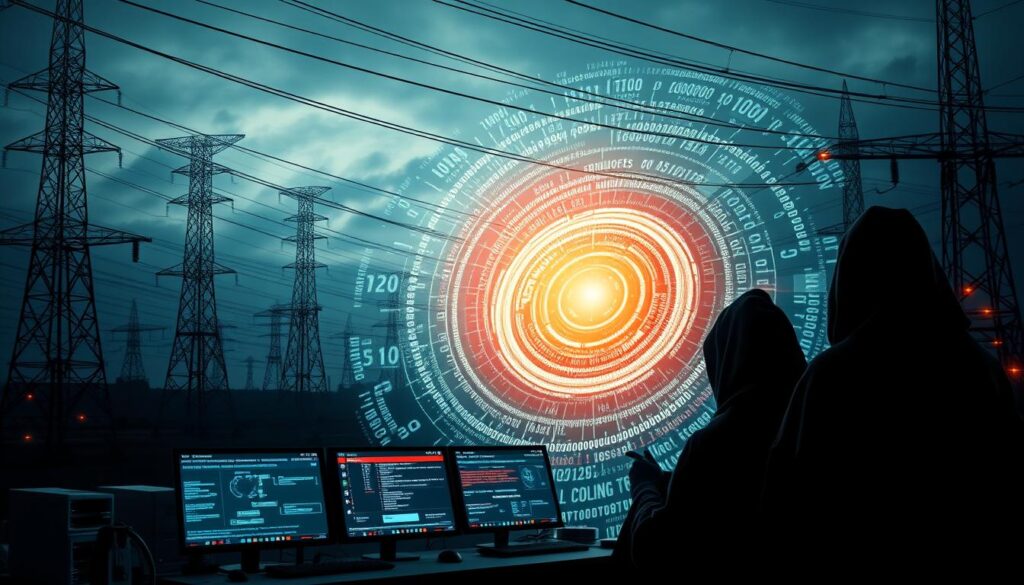Emera Inc. and Nova Scotia Power announced on April 25, 2025, that they had discovered a cybersecurity incident involving unauthorized access to certain parts of their Canadian network and servers supporting business applications.
The companies immediately took action to respond to the incident, leveraging their next-gen security measures to contain and mitigate the issue.
The discovery and response efforts demonstrate the companies’ commitment to protecting their systems and data. Further actions are being taken to prevent similar incidents in the future.
Key Takeaways
- Emera and Nova Scotia Power detected a cybersecurity incident on April 25, 2025.
- The incident involved unauthorized access to parts of their network and servers.
- The companies are actively responding to the incident.
- Immediate actions were taken to contain and mitigate the issue.
- Emera and Nova Scotia Power are committed to protecting their systems and data.
The Cybersecurity Breach: What Happened at Emera and Nova Scotia Power
On April 25, 2025, Emera and Nova Scotia Power detected a sophisticated cybersecurity breach that triggered an immediate response from their incident response teams. Upon detection, the companies swiftly activated their incident response and business continuity protocols to mitigate potential damage.
Timeline of the April 25, 2025 Attack
The attack timeline reveals that the breach was identified during a routine security monitoring process. The incident response team quickly assessed the situation and initiated containment procedures to prevent further unauthorized access.
- The breach was detected on April 25, 2025, at 08:00 AM.
- Initial assessment and containment measures were completed by 10:00 AM.
- Third-party cybersecurity experts were engaged by 12:00 PM to assist in the response efforts.
Nature of the Unauthorized Access
Preliminary investigations indicate that the unauthorized access was the result of a highly sophisticated phishing campaign targeting specific employees. The attackers exploited vulnerabilities in the companies’ email systems to gain initial access to their networks.
Systems and Networks Affected
The breach affected certain business applications and networks within Emera and Nova Scotia Power. However, due to the swift action of the incident response teams, critical infrastructure and customer data remained secure.
The companies’ prompt response and collaboration with cybersecurity experts ensured that the breach was contained, and further intrusion was prevented. The incident highlighted the importance of robust cybersecurity measures and the need for continuous vigilance in the face of evolving threats.
About Emera and Nova Scotia Power: Company Background
Understanding the background of Emera and Nova Scotia Power is crucial in grasping the implications of the recent cybersecurity incident. Both companies play vital roles in their respective regions, providing essential energy services.
Emera’s Role in the Energy Sector
Emera is a diversified energy company with a significant presence in the North American energy market. It operates through various subsidiaries, providing electricity and gas to customers across several jurisdictions. Emera’s diversified portfolio includes both regulated and non-regulated businesses, allowing it to maintain a strong market position.
Nova Scotia Power’s Infrastructure and Services
Nova Scotia Power, a subsidiary of Emera, is the primary electricity provider in Nova Scotia, Canada. It manages a comprehensive network of power generation, transmission, and distribution infrastructure. The company is committed to delivering reliable electricity to its customers while navigating the complexities of the energy market.
Previous Security Posture and Measures
Both Emera and Nova Scotia Power have historically prioritized the security of their infrastructure and customer data. They have implemented various security measures, including advanced threat detection systems and regular security audits, to protect against cyber threats. Despite these efforts, the recent incident highlights the evolving nature of cybersecurity challenges in the energy sector.
Immediate Response Actions Taken by the Companies
Emera and Nova Scotia Power responded swiftly to the cybersecurity breach, initiating their comprehensive incident response plans. This immediate action was crucial in mitigating the impact of the breach.
Activation of Incident Response Protocols
The companies activated their incident response protocols, which included alerting key personnel and assembling a response team. This team was tasked with assessing the situation and implementing measures to contain the breach.
Containment and Isolation Measures
To prevent further unauthorized access, Emera and Nova Scotia Power implemented containment measures, isolating affected systems and networks. This swift action helped minimize potential damage.
Engagement with Law Enforcement
Law enforcement officials were notified, and the companies worked closely with them to investigate the breach. This collaboration was essential in understanding the nature of the attack and identifying the perpetrators.
The immediate response actions taken by Emera and Nova Scotia Power demonstrate their commitment to cybersecurity and their ability to respond effectively to incidents. By activating their incident response protocols, containing the breach, and engaging with law enforcement, the companies were able to mitigate the impact of the cybersecurity incident.
Impact Assessment: What Was and Wasn’t Affected
Emera and Nova Scotia Power swiftly initiated an impact assessment after discovering the cybersecurity incident. This assessment aimed to determine the extent of the breach’s impact on their operations and data.
Status of Physical Operations
Reassuringly, there was no disruption to any of our Canadian physical operations, including at Nova Scotia Power’s generation facilities. The incident was contained within the digital realm, ensuring the continuity of our critical infrastructure and services.
Business Applications Compromised
Our investigation revealed that certain business applications were accessed during the breach. However, robust security measures were in place, minimizing potential damage. Immediate action was taken to isolate these applications and enhance their security.
Customer Data Security Status
We are pleased to report that customer data security was not compromised. Our systems and protocols protected sensitive information, ensuring the privacy and security of our customers’ data.
The incident highlighted the importance of continuous vigilance and enhancement of our cybersecurity measures to protect against evolving threats.
Implementing Incident Response Next-Gen AV Solutions
Emera and Nova Scotia Power are leveraging cutting-edge next-gen AV technology to improve their incident response protocols and protect against future cyber threats. This strategic move is in response to the recent cybersecurity incident, aiming to bolster their defenses with advanced threat detection and mitigation capabilities.
Next-Generation Antivirus Technology Explained
Next-generation antivirus technology represents a significant advancement over traditional antivirus software. Unlike conventional AV solutions that rely heavily on signature-based detection, next-gen AV technology incorporates a multi-layered approach to identify and combat complex cyber threats. As noted by cybersecurity experts, “Next-gen AV solutions are designed to detect and respond to sophisticated attacks that traditional antivirus software might miss.”
“The future of cybersecurity lies in predictive analytics and machine learning, enabling systems to anticipate and counter threats before they materialize.” – Cybersecurity Expert
Key components of next-gen AV technology include behavioral analysis and machine learning algorithms that enable real-time threat detection and response.
Behavioral Analysis and Machine Learning Components
Behavioral analysis is a critical feature of next-gen AV solutions, allowing systems to monitor and analyze the behavior of files and applications in real-time. This approach helps identify potentially malicious activities that may not be caught by traditional signature-based detection methods. Machine learning further enhances this capability by enabling the system to learn from new data and improve its detection accuracy over time.
Real-Time Threat Detection and Response Capabilities
One of the standout features of next-gen AV technology is its ability to detect and respond to threats in real-time. This capability is crucial in minimizing the impact of a cyber attack, as it allows for swift action to be taken against potential threats. The integration of real-time threat intelligence feeds further enhances this capability, providing up-to-date information on emerging threats.
Integration with Existing Security Infrastructure
To maximize their effectiveness, next-gen AV solutions are designed to integrate seamlessly with existing security infrastructure. This integration ensures that all components of the security framework work together cohesively, providing comprehensive protection against a wide range of cyber threats. By combining next-gen AV technology with other security measures, Emera and Nova Scotia Power can significantly enhance their overall cybersecurity posture.
The Role of Third-Party Cybersecurity Experts in the Response
In response to the cybersecurity incident, Emera and Nova Scotia Power engaged leading third-party cybersecurity experts to bolster their incident response efforts. This strategic decision underscored the complexity of the breach and the need for specialized knowledge to effectively manage and mitigate its impact.

Specialized Teams Deployed
The third-party cybersecurity experts deployed specialized teams with expertise in handling complex cybersecurity incidents. These teams brought a wealth of experience and cutting-edge tools to the table, enabling a comprehensive response to the breach.
Forensic Investigation Process
A critical component of the response was the forensic investigation conducted by these experts. This process involved a meticulous analysis of the breach to determine its scope, identify the vulnerabilities exploited by the attackers, and understand the methods used to gain unauthorized access.
Threat Intelligence Gathering
Furthermore, the third-party experts were instrumental in threat intelligence gathering. By analyzing the incident, they were able to gather valuable insights into the tactics, techniques, and procedures (TTPs) employed by the threat actors. This intelligence is crucial for enhancing the security posture of Emera and Nova Scotia Power, as well as for informing the broader cybersecurity community about emerging threats.
The engagement of third-party cybersecurity experts significantly enhanced the response to the cybersecurity incident, demonstrating the value of external expertise in managing complex security breaches.
Implications for Customers and the Public
The cybersecurity incident at Emera and Nova Scotia Power has significant implications for customers and the public. As the companies respond to the breach, several key areas of concern have emerged, including how they communicate with their customers, ensure service continuity, and protect customer data.
Communication Strategy During the Incident
Emera and Nova Scotia Power have implemented a comprehensive communication strategy to keep customers informed about the incident. This includes regular updates through their official websites, social media, and direct customer notifications. Transparent communication is crucial in maintaining customer trust during such incidents.
Service Continuity Assurances
Both companies have assured customers that their operations and services will continue uninterrupted. Measures have been taken to ensure that the breach does not affect the delivery of electricity and other essential services. Service continuity is a top priority, and customers can expect minimal disruption.
Data Privacy Concerns and Protections
Customer data privacy is a significant concern following the breach. Emera and Nova Scotia Power are working closely with cybersecurity experts to protect customer data. They have assured that all necessary steps are being taken to prevent any misuse of customer information.
In conclusion, while the cybersecurity incident poses challenges, Emera and Nova Scotia Power are taking proactive steps to address customer and public concerns. Through transparent communication, service continuity assurances, and robust data privacy protections, the companies aim to maintain customer trust and confidence.
Cybersecurity Threats Facing Utility Companies in 2025
As we approach 2025, utility companies are facing an increasingly complex landscape of cybersecurity threats. The energy sector, in particular, is a critical infrastructure that is vulnerable to various forms of cyberattacks.
Evolving Threat Landscape
The threat landscape for utility companies is continuously evolving, with new threats emerging as technology advances. Advanced Persistent Threats (APTs) are becoming more common, where attackers remain undetected in the system for extended periods.
Common Attack Vectors Against Energy Infrastructure
Attackers often exploit vulnerabilities in the energy infrastructure through phishing attacks, malware, and exploiting unpatched vulnerabilities. Utility companies must be aware of these common attack vectors to implement effective countermeasures.

Nation-State Actors vs. Criminal Organizations
The threat to utility companies comes from both nation-state actors and criminal organizations. Nation-state actors may seek to disrupt critical infrastructure, while criminal organizations are often motivated by financial gain. Understanding the motivations behind these threats is crucial for developing effective cybersecurity strategies.
In conclusion, the cybersecurity threats facing utility companies in 2025 are multifaceted and require a comprehensive approach to mitigate. By understanding the evolving threat landscape, common attack vectors, and the role of different threat actors, utility companies can better prepare to defend against these threats.
Industry Expert Analysis and Similar Incidents
Industry experts are weighing in on the recent cybersecurity incident at Emera and Nova Scotia Power, drawing parallels with other utility breaches. Their analysis provides valuable insights into the incident’s impact and the effectiveness of the companies’ response.
Comparative Analysis with Recent Utility Breaches
A comparative analysis with recent utility breaches reveals that the incident at Emera and Nova Scotia Power shares similarities with other attacks in the sector. Common vulnerabilities exploited in these breaches include outdated software and inadequate network segmentation. Experts note that the attackers’ tactics, techniques, and procedures (TTPs) are becoming increasingly sophisticated.
Expert Opinions on Response Effectiveness
Experts have praised Emera and Nova Scotia Power for their swift response to the incident, noting that prompt action likely minimized potential damage. The companies’ incident response plans were activated quickly, and they engaged with law enforcement and cybersecurity experts to contain the breach.
Best Practices Emerging from These Incidents
Best practices emerging from these incidents include the importance of regular security audits and employee training. Experts also emphasize the need for continuous monitoring and improvement of cybersecurity measures to stay ahead of evolving threats.
Conclusion: Lessons Learned and Moving Forward
Emera and Nova Scotia Power’s response to the cybersecurity incident demonstrates the importance of effective cybersecurity incident response in the energy sector. The incident highlights the need for robust security measures to protect against evolving threats.
Key lessons learned from this incident include the importance of swift action, collaboration with law enforcement and third-party experts, and transparent communication with customers. As the energy sector continues to evolve, companies must prioritize cybersecurity to ensure the reliability and security of their services.
Moving forward, Emera and Nova Scotia Power will likely continue to enhance their cybersecurity posture, incorporating next-generation antivirus solutions and threat intelligence gathering to stay ahead of potential threats. This incident serves as a reminder of the ongoing need for vigilance in cybersecurity incident response.





